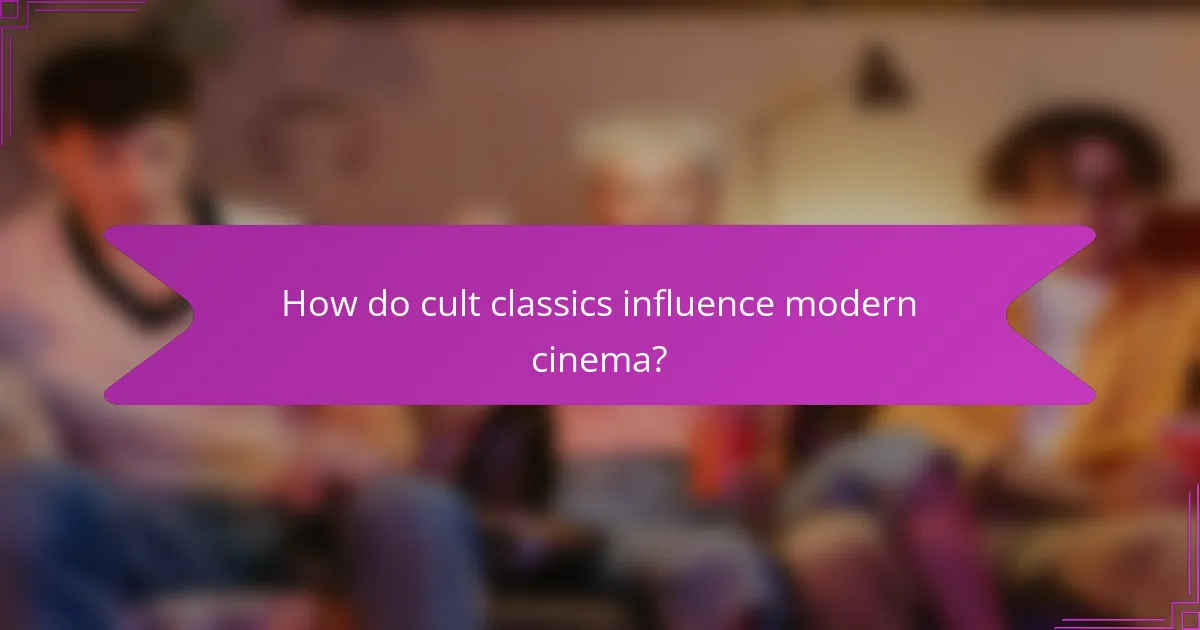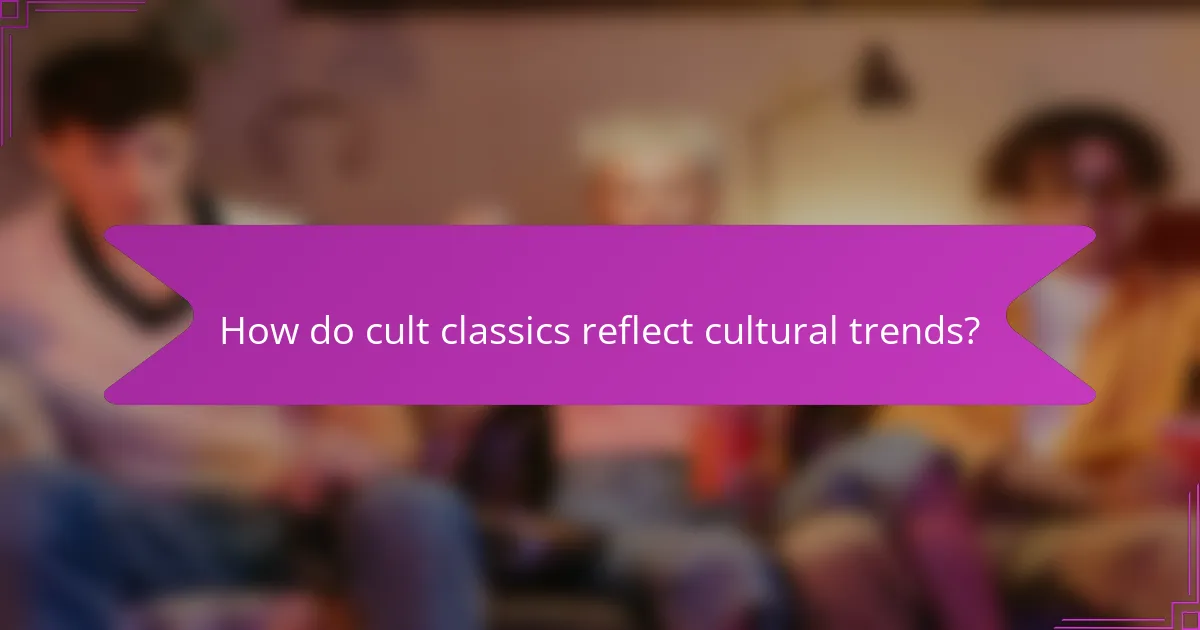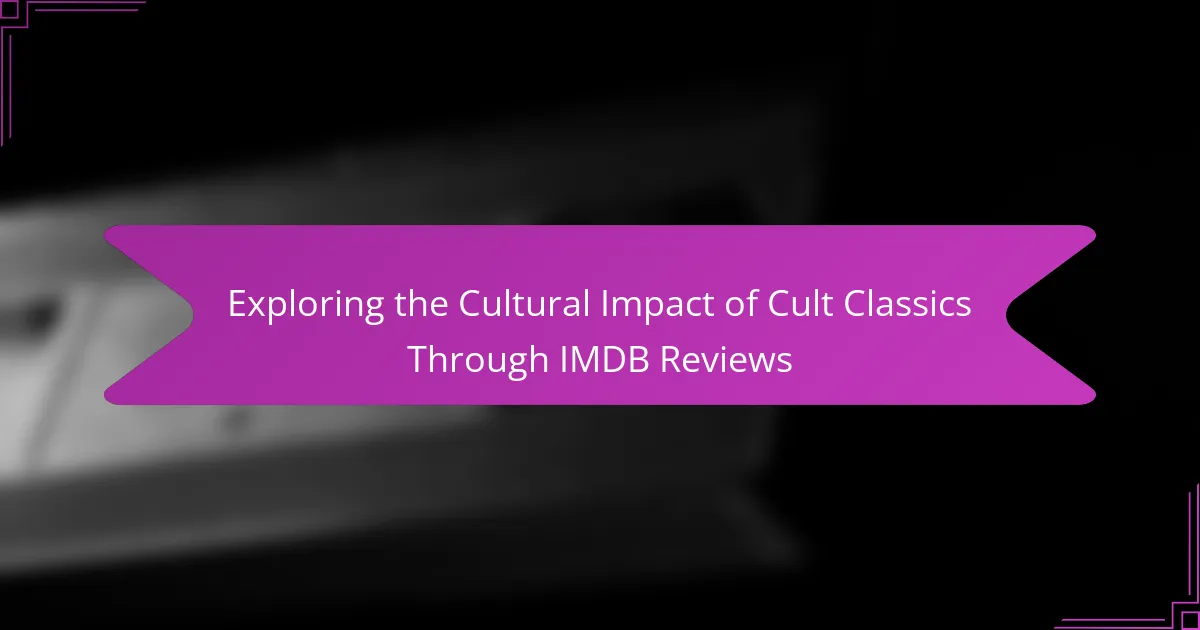Cult classics play a pivotal role in shaping modern cinema by introducing innovative storytelling techniques and genre conventions that inspire filmmakers. Through IMDB reviews, we can gain valuable insights into viewer sentiments and the cultural significance of these films, revealing how audiences engage with their unique narratives. These movies often reflect societal trends and values, making them essential for understanding cultural dynamics over time.

How do cult classics influence modern cinema?
Cult classics significantly shape modern cinema by introducing unique storytelling methods, genre conventions, and inspiring filmmakers. Their unconventional narratives and dedicated fan bases often lead to new trends and creative approaches in film production.
Impact on storytelling techniques
Cult classics often employ non-linear narratives, unreliable narrators, and unconventional character arcs that challenge traditional storytelling. Films like “Pulp Fiction” and “The Big Lebowski” showcase these techniques, encouraging filmmakers to experiment with structure and perspective.
This influence can be seen in contemporary films that prioritize character development over plot, allowing for deeper emotional connections. Filmmakers are encouraged to take risks, leading to innovative storytelling that resonates with audiences seeking fresh experiences.
Shaping genre conventions
This blending of genres has led to a rise in hybrid films, where creators feel liberated to mix tropes from different categories. As a result, audiences are treated to unique cinematic experiences that challenge their expectations and expand their appreciation for diverse storytelling.
Influence on filmmakers
Cult classics inspire a new generation of filmmakers by showcasing the potential for artistic expression outside mainstream norms. Directors like Quentin Tarantino and the Coen Brothers have cited these films as pivotal influences in their own work, encouraging them to embrace originality and authenticity.
Emerging filmmakers can learn from cult classics by studying their unique marketing strategies and community engagement. Building a loyal fan base through social media and grassroots campaigns can help independent films gain traction, mirroring the success of past cult favorites.

What insights do IMDB reviews provide about cult classics?
IMDB reviews offer valuable insights into cult classics by highlighting viewer sentiments, recurring themes, and the cultural significance of these films. They reflect how audiences engage with and interpret the unique elements that make these movies resonate over time.
Common themes in reviews
Many IMDB reviews of cult classics focus on themes such as nostalgia, unconventional storytelling, and memorable characters. Reviewers often express a deep emotional connection to the film, citing specific scenes or quotes that have left a lasting impact. This emotional resonance is a key factor in defining a film as a cult classic.
Additionally, humor and satire frequently emerge as common themes, with viewers appreciating the films’ ability to challenge societal norms or provoke thought. These elements contribute to a film’s cult status, as they often inspire passionate discussions among fans.
Viewer demographics and preferences
IMDB reviews reveal that cult classic audiences tend to be diverse, spanning various age groups and backgrounds. However, many reviewers are typically younger adults who appreciate the films’ unique perspectives and subversive qualities. This demographic often seeks out films that offer a break from mainstream cinema.
Preferences can vary widely, with some viewers drawn to horror cult classics for their shock value, while others favor comedies for their clever writing. Understanding these demographics helps filmmakers and marketers target their audiences more effectively.
Critical reception versus audience perception
There is often a significant disparity between critical reception and audience perception of cult classics. Critics may focus on technical aspects or mainstream appeal, while audiences tend to prioritize emotional engagement and personal connection. This divergence can lead to films being overlooked by critics but celebrated by fans.
For instance, a film that receives mixed reviews from critics may develop a strong following over time, as viewers appreciate its quirks and idiosyncrasies. This phenomenon underscores the importance of audience reviews in shaping a film’s legacy and cultural impact.

How do cult classics reflect cultural trends?
Cult classics often serve as mirrors to cultural trends, encapsulating the values, struggles, and aspirations of their time. They resonate with audiences by addressing societal issues and reflecting evolving tastes, making them significant in understanding cultural dynamics.
Representation of societal issues
Cult classics frequently highlight pressing societal issues, such as inequality, mental health, and identity struggles. Films like “The Breakfast Club” and “Fight Club” delve into themes of alienation and the search for belonging, resonating with viewers who identify with these challenges.
These films can spark conversations about the very issues they portray, encouraging audiences to reflect on their own experiences and societal norms. By tackling controversial topics, cult classics often become catalysts for change and awareness.
Evolution of audience tastes
The tastes of audiences evolve over time, and cult classics often reflect these shifts. For instance, the rise of independent films in the 1990s introduced unique storytelling styles and character-driven narratives, appealing to a generation seeking authenticity.
As cultural values change, so do the themes and genres that resonate with viewers. Cult classics often gain traction by pushing boundaries and challenging conventional norms, ultimately influencing mainstream cinema.
Impact on fashion and music
Cult classics significantly influence fashion and music trends, often setting styles that become iconic. Films like “Clueless” popularized specific fashion aesthetics, while soundtracks from movies such as “Pulp Fiction” introduced audiences to new musical genres and artists.
These cultural artifacts can lead to revivals of past styles or the emergence of new trends, as fans adopt the looks and sounds associated with their favorite films. The impact is often seen in fashion runways and music charts, where cult classic references become mainstream.

What are the characteristics of cult classics?
Cult classics are films or shows that have developed a dedicated following despite often being overlooked by mainstream audiences. They typically feature unconventional narratives, unique aesthetics, and themes that resonate deeply with specific groups, leading to a lasting cultural impact.
Unique storytelling elements
Cult classics often showcase unconventional storytelling techniques that challenge traditional narrative structures. This can include non-linear plots, surreal elements, or unexpected character arcs that captivate audiences looking for something different. For instance, films like “Donnie Darko” and “The Rocky Horror Picture Show” incorporate elements that defy typical genre conventions.
These unique storytelling elements encourage viewers to engage with the material on a deeper level, often inviting multiple interpretations. This complexity can foster discussions and analyses that further solidify a film’s cult status.
Dedicated fan bases
A defining characteristic of cult classics is their passionate and loyal fan bases. These communities often engage in activities such as fan art creation, cosplay, and organized screenings, which help maintain the film’s relevance over time. For example, “The Big Lebowski” has inspired a dedicated following that celebrates its quirky characters and memorable moments through annual festivals.
Fans often form online forums and social media groups to discuss theories, share memorabilia, and promote events, creating a sense of belonging among like-minded individuals. This communal aspect is crucial for the longevity of cult classics.
Memorable quotes and scenes
Memorable quotes and iconic scenes are hallmarks of cult classics, often becoming ingrained in popular culture. Phrases like “Here’s looking at you, kid” from “Casablanca” or “I’m not a witch, I’m your wife!” from “The Princess Bride” are frequently referenced in various contexts, enhancing their cultural significance.
These quotes and scenes contribute to the film’s identity and are often used in everyday conversation, allowing fans to connect through shared references. This phenomenon can also lead to the creation of merchandise and parodies, further embedding the film in popular culture.

How do cult classics differ from mainstream films?
Cult classics are films that, despite often low budgets and limited initial success, develop a dedicated fanbase over time, distinguishing them from mainstream films that typically achieve widespread popularity and commercial success. These films often embody unique themes, unconventional storytelling, and a distinctive aesthetic that resonates deeply with niche audiences.
Budget and production differences
Cult classics usually operate on significantly lower budgets compared to mainstream films, often ranging from a few hundred thousand to several million dollars. This financial constraint encourages creativity and innovation, leading filmmakers to explore unconventional narratives and styles that might not appeal to broader audiences.
For example, films like “The Room” and “Eraserhead” were produced with minimal funding but gained notoriety for their unique storytelling and production choices. This contrasts sharply with mainstream films, which often have budgets in the tens or hundreds of millions, allowing for high-profile casts and extensive special effects.
Distribution methods
The distribution of cult classics often relies on alternative methods, such as film festivals, midnight screenings, and grassroots marketing, rather than traditional wide releases. These films may initially struggle to find an audience but can gain traction through word-of-mouth and dedicated fan events.
In contrast, mainstream films typically benefit from extensive marketing campaigns and wide theatrical releases, ensuring they reach a broad audience quickly. Cult classics may eventually find success through platforms like streaming services or home video, where they can cultivate a following over time.



